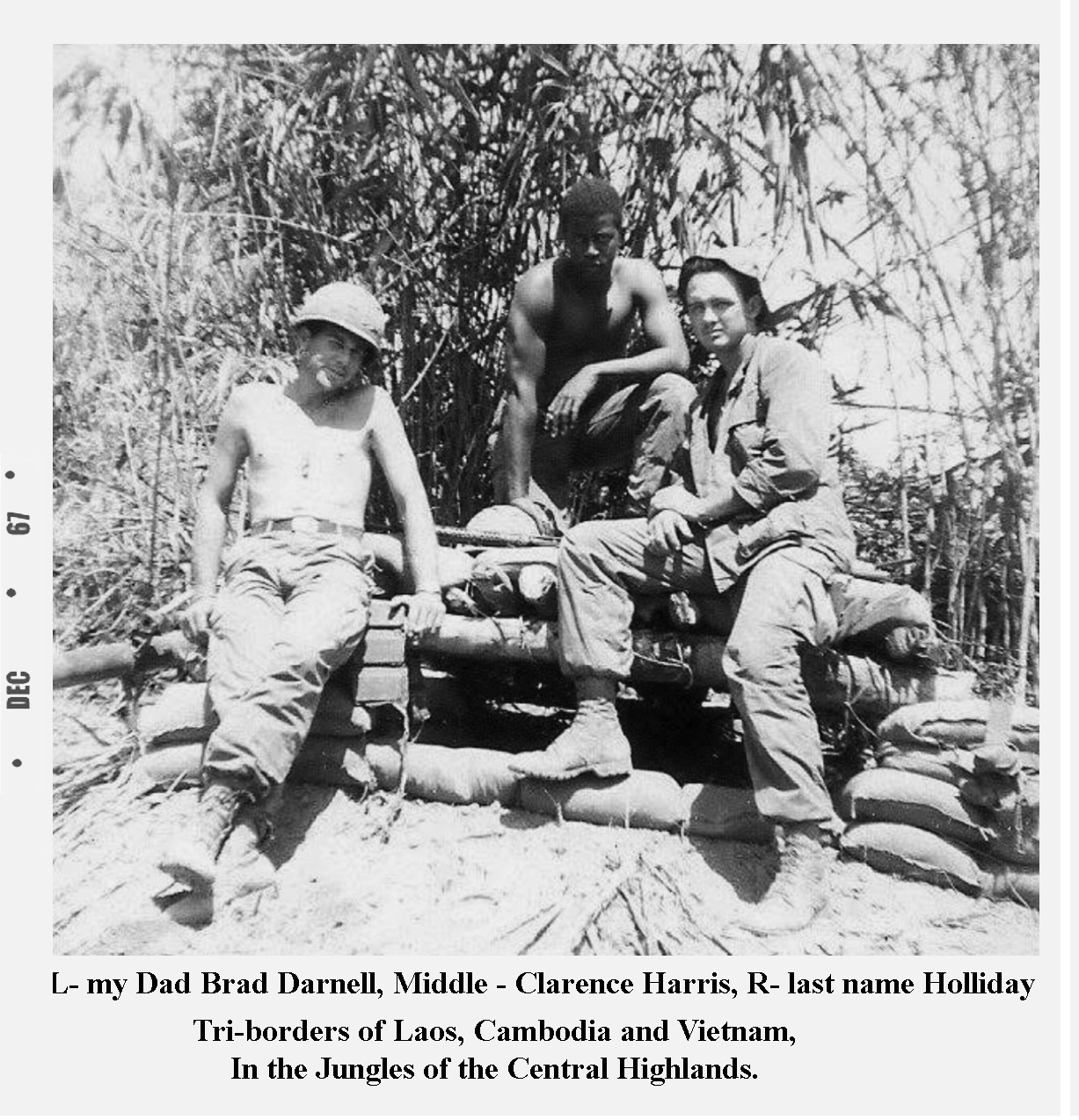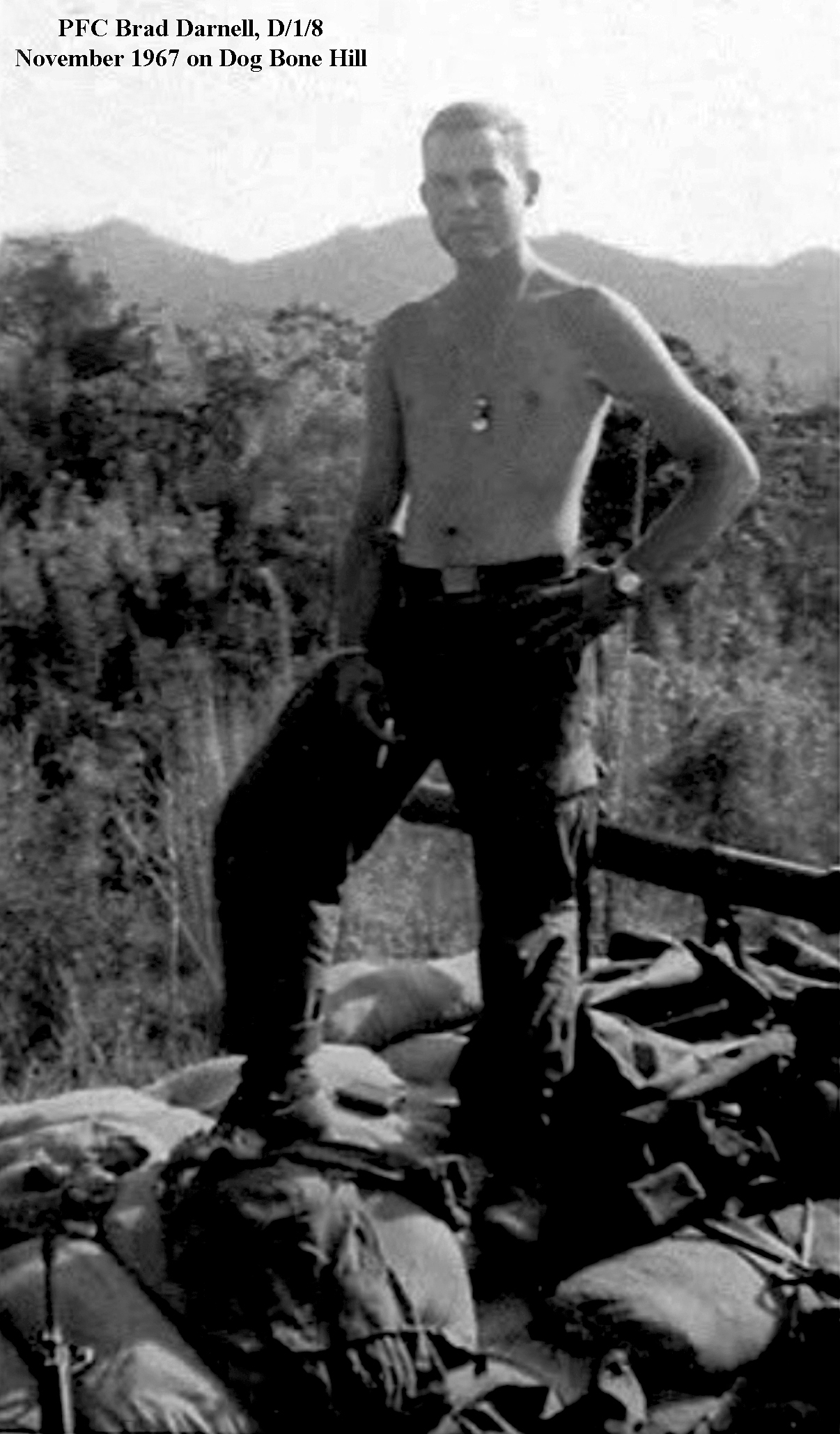PFC Brad Darnell
D Company, 1st Battalion, 8th Infantry
4th Infantry Division
The Battle of Dak To -- Memories from Vietnam
My parents met through mutual friends and dated a little over a year before my dad was drafted in the spring of 1967. They got engaged and my mom planned their wedding during her senior year of high school, while my dad took a journey halfway around the world to help defend the South Vietnamese in a controversial war. He turned 20 years old during basic training at Fort Benning, Georgia. After those six weeks were up, he was sent to AIT at Fort McClellan, Alabama. There he would have an 8-week crash course on how to stay alive in a foreign country under enemy fire.
He arrived at Cam Ranh Airport on October 7th, 1967, along with 100 or so other young soldiers. He spent the first few nights at a replacement center and was then assigned to the 4th Infantry Division and sent to their area of operations in the Central Highlands. In mid-November, army intelligence operatives detected structures that looked like a North Vietnamese headquarters area, just a short distance from the Cambodian border. That area, which would become known as Dog Bone Hill, was a convenient place to fire mortars and rockets into the American base at Dak To.

The 1st Battalion, 8th Infantry including Alpha, Charlie, and Delta Company (where my dad served) was chosen to attack Dog Bone Hill. After Dog Bone Hill was blasted by artillery and airstrikes, the 1st battalion units were helicoptered to the hill, quickly occupied the area, and established a fortified defensive position. My dad's company stayed here for several days and was then helicoptered to another nearby location on November 17th into a clearing that had already been bombed.
Hours later, on the 17th, the North Vietnamese Army assaulted the 1st Battalion, 8th Infantry Firebase on Dog Bone Hill. The North Vietnamese hit the base with fire from automatic weapons, 82mm mortars, and 122mm rockets. This NVA attempt to break free from the trap set by American positions on the hills surrounding Dak To lasted ten days. In that time, more than 500 enemy rounds landed on or around Dog Bone Hill.
On the night of November 18th, my dad and two other soldiers from his squad were on Listening Post. They were there all night and headed back to camp at daybreak. When they arrived back at their bunker, the other six soldiers in their squad had already left for the day's patrol. Around 1:00 PM, someone from another unit told the three of them that they could take a bath in a nearby creek. They hadn't bathed in about three weeks, so the three of them left for the creek. Shortly after getting in the water, mortar rounds began flying around them. My dad immediately went underwater and heard five or six more rounds being launched from the mortar tube. He knew he had to get out of the area. He jumped out of the creek and put on his pants. He was hit in the side with a large piece of shrapnel. He grabbed it and pulled it out, picked up his rifle and boots, and ran barefoot back up the hill to camp.
When the three of them arrived back at the camp, they were sent to assist in a different area of the perimeter. The soldiers there had also been fired on and there were several wounded, with one fatality. They dragged the body of Sergeant Reed back up the hill, while still under enemy fire. My dad, along with the other two from his squad, were sent with another group to Recon the area and then returned to their bunker. Just before dusk, three of the six soldiers who had left at daybreak returned. Their squad leader, who was wearing a PRC-25 radio, had been shot through the radio, so they had no communications. Two others in the squad were killed, including my dad s best friend, PFC Joseph Gene Gregg (November 19, 1967).
Gregg s body had not been recovered yet and all his belongings were right where he left them. The next day, the bodies of the three fallen soldiers were brought back and sent to Graves Registration. The following sunrise would bring the same repeated uncertainty for my dad, not knowing if he would survive the day. But now it seemed even more real because one-third of the squad had been killed. But there was no time to grieve because they had to keep moving and stay focused on survival. My dad s company stayed at this camp for about two more days, then moved closer to Dak To.

As Thanksgiving neared, the NVA were on a hill that the U.S. Army wanted. It was Hill 875. The Army's 173rd Airborne Brigade was there, but it was proving to be a large and brutal fight. More units were preparing to join the battle. The day before Thanksgiving, his unit heard that they may be the next ones sent to Hill 875. They waited in anticipation of what the next hours would bring.
On Thanksgiving Day, they were told that U.S. troops had taken Hill 875. Instead of helicopters picking them up to drop them off in battle, they would bring supplies. That day, they were delivered fresh uniforms, mail that had been stockpiled at base camp, and a hot Thanksgiving feast prepared by the camp's cooks and served by the officers. It was likely the best meal they had while they were there at the conclusion of one of the bloodiest battles of the Vietnam War. The fight for Hill 875 was an 110-hour battle, which resulted in significant casualties for both the PAVN and U.S. forces. There were approximately 300 Americans killed, over 1000 wounded, and 16 missing. The North Vietnamese estimated between 1200 and 1400 killed and 3000 wounded. The heavy losses for the NVA crippled several regiments and significantly impacted their ability to participate in the upcoming Tet Offensive.
Posted 18 OCT 2025
You can make contact via email to the Swamp_fox address at the bottom of this page and I will forward your email to her.